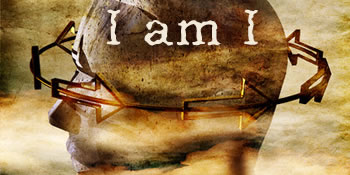
The philosopher Descartes tried to establish what it was that a person can know with absolute certainty. Although one may see many things in one's environment -- trees, houses, automobiles, people -- and one can be virtually certain that they are all real, one cannot be absolutely certain of this. We know that there is a phenomenon of hallucination, wherein a person sees things that do not exist, yet for that person they are very, very real. While it may be absurd to think that one is hallucinating everything one sees, if one wants to be absolutely and scientifically certain of something, he must consider even the most absurd possibility.
Thus, says Descartes, one cannot be certain of anything that one knows by a sense perception, since these are all subject to hallucination. But one does know this much for certain, that even if one is hallucinating, one does "exist." A person cannot hallucinate unless he exists to do the hallucinating! Therefore, Descartes concludes, the only thing that one can know for certain is that one exists. This leads to the famous Cartesian doctrine -- cogito ergo sum, I think, therefore I am.
We might try a somewhat similar approach in trying to establish an identity, a method that will allow us to have an identity that is not contingent on outside sources. It is not because we can argue like Descartes that the outside world does not exist. We can accept the obvious, that people are real and that the things we see are real, yet we should not allow these external realities to be the basis whereby we establish our identity.
Allowing others to establish our identity runs the risk of making one into a chameleon, as one continually changes identities according to what others say one is. At best one becomes a composite of the various identities one assumes. It should be evident that many important decisions in life depend on one's identity, and the decisions made in the presence of a vacillating or poorly defined identity may be less than optimum.
Should not choices in life be an outgrowth of one's identity? Yet, if one has an identity, say, as a physician, then one was not a physician prior to entering medical school. What, then, was the identity of the person who elected to become a physician? Should not marriage and family be based on one's identity? Is it not absurd to choose a marriage partner as a companion for life, when one does not know who one is? Is it not possible that the failure of so many marriages may be attributed to either one or both partners having made a decision wherein they selected someone for themselves or offered themselves to someone without an awareness of their own identity?
The prevalence of externally determined identities appears to be significant. It is only logical to assume that external identities are adopted where there is a vacuum; i.e., where no internal identity exists.
The problem arises that once an externally-imposed identity is adopted, that vacuum is filled, which means that there is now no place for an internal identity to develop, even if a person should wish to obtain one. The latter cannot be achieved until the space it is to occupy is first vacated. In other words, we must first divest ourselves of an externally-imposed identity in order to develop an internal identity, and this is not a simple feat. There may be an interim during which one is without an identity, and this may prove very threatening to an individual.
For example, lobsters are limited in their growth by a rigid, external shell. In order for a lobster to grow, it must first shed its shell and grow a new shell to accommodate its increased mass. During the interval that the lobster is without its protective shell, it is vulnerable to being devoured by predatory fish. Similarly, shedding one's external identity in order to make room for an internal one can be perceived as being equally menacing.
An individual who has suffered amnesia may suddenly awake to find himself in a strange city. Not knowing who he is or how he arrived there, and also not acquainted with a single soul in the city, he will promptly adopt a name. It appears that a person must have some way of introducing himself to others. Just as one cannot function without a name, so one cannot function without an identity. Hence, the shedding of an external identity in order to adopt an internal one may provoke a great deal of anxiety, so much so, that one may elect to stay with the external identity even if it is not valid.
For the Jew, the Revelation at Sinai, as expounded upon in the Scriptures, Talmud and Kabbalah, provides the basis for an internal identity. We are taught that every person has a soul of Divine origin, and every person has a special place in Creation. Every individual was created for a specific mission, which is accomplished by fulfillment of Torah and mitzvot.
From the Torah perspective, it is Torah that gives a person an internal identity: "I am a person created for the specific purpose of fulfilling the Divine will as revealed in the Torah. That is my identity, and that is who I am, whether I am woman or man, rich or poor, healthy or ill -- and that is my identity regardless of where I am or whatever I do."
Originally published in "I AM I"-- a Jewish perspective from the case files of an eminent psychiatrist.
Rabbi Abraham Twerski, M.D. is a nationally acknowledged expert in the field of alcoholism and chemical dependency, and is currently the Medical Director of the Gateway Rehabilitation Center in Pittsburgh, as well as an Associate Professor of Psychiatry at the University of Pittsburgh School of Medicine.

